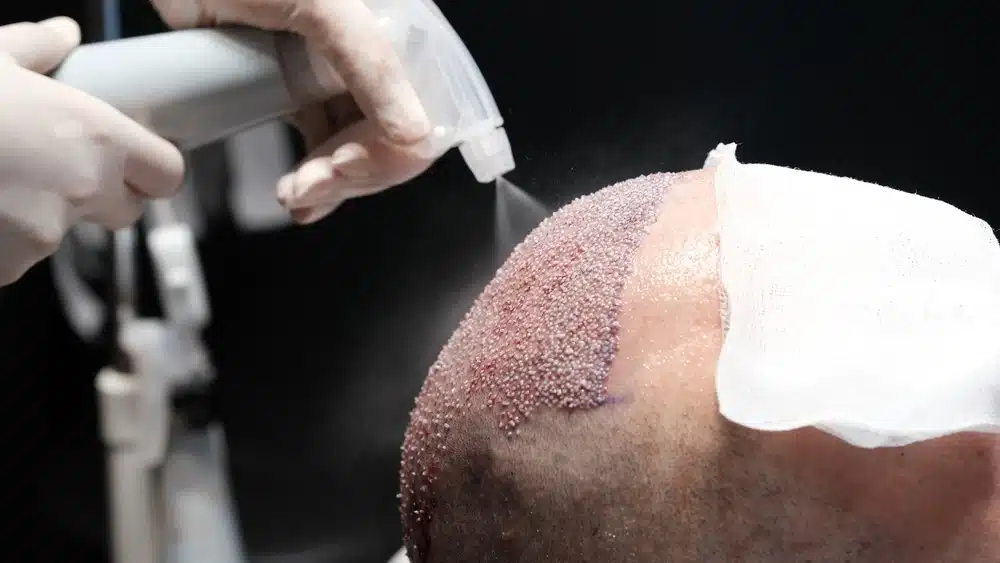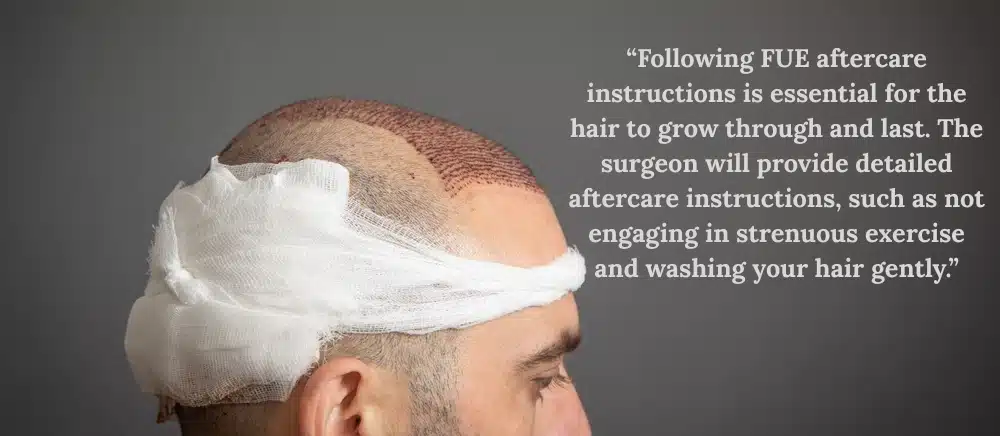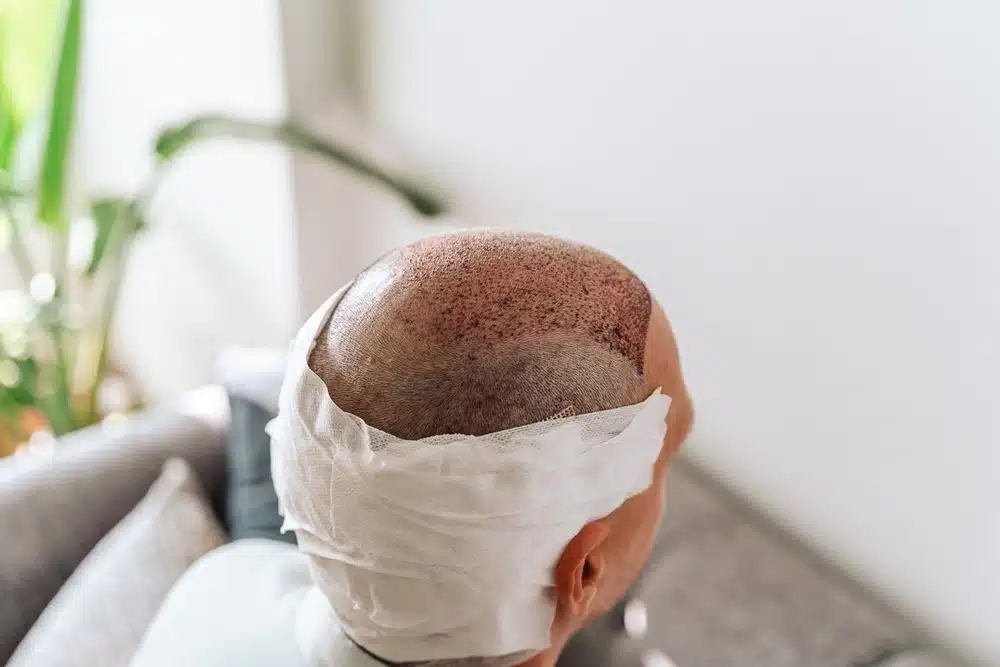A FUE hair transplant is a popular minimally invasive surgery that gives you a chance to regrow a full head of hair. From the outside, the process may seem pretty simple, but it’s important to know exactly what to expect over time, including how to ensure the FUE hair transplant results stand the test of time.
So, how long does FUE last? Do FUE hair transplants last at all? Find out all you need to know right here!
Understanding the FUE Hair Transplant Process
First, let’s understand the FUE hair transplant surgical procedure.
FUE stands for follicular unit extraction. It is a hair transplantation surgery technique that involves using a micro punch tool that carefully and precisely extracts individual hair follicles from the donor area and then implants them into the recipient area. The donor hair follicles then take root in the new recipient area and start growing new hairs.
It’s a specialised process known for its minimal scarring and fast healing. Another popular method is the follicular unit transplantation FUT method, which extracts a strip of skin rather than individual follicles, thus leaving more scarring.
FUE Hair Transplant: How Long Does it Last?
So, how long does FUE last, exactly?
One of the best things about FUE hair transplants is that they are a permanent solution to achieving natural hair growth once more. After this hair transplant procedure, patients can expect the new hairs to keep on growing for life, cycling through the natural hair growth cycle, which includes the growing, resting, and shedding phases. [1]
It should be noted, though, that some people find they need a follow-up hair transplant procedure for the results to truly last long-term. There are a few reasons this can happen, such as having a poor donor area, not following aftercare properly, or not choosing the right hair transplant clinic.
What Affects Hair Transplant Longevity?
Here, we’ll go into the different factors that can affect the longevity of a FUE hair transplant.
Graft Rejection: Occasionally, the body fails to accept the new grafts, resulting in an unsuccessful hair transplant procedure. There are a few reasons this can happen, such as not enough blood circulation to the scalp or an immune response.
Hair Loss Progression: If a person is still losing their hair, that hair loss progression can impact the results of the hair restoration surgery. This is more common in patients who are younger.
The Surgeon’s Skill: The surgeon’s skill greatly impacts the results of a FUE hair transplant. Without proper expertise, a surgeon may not use the proper techniques to ensure the implanted hair follicles are successful and grow new hairs.
Aftercare: Following FUE aftercare instructions is essential for the hair to grow through and last. The surgeon will provide detailed aftercare instructions, such as not engaging in strenuous exercise and washing your hair gently.
What to Expect at Each Stage
Are you preparing for a FUE hair transplant and want to ensure the transplanted hair follicles take root and successfully grow new hair? It helps to understand what to expect at each stage.
- The Surgery
The day of the surgery will involve actually undergoing the FUE procedure. The surgeon will provide a local anaesthetic to prevent pain during the surgery, and then they will extract hair follicles from your donor area and implant them into your bald areas, making small incisions to do so. Following the surgery, your surgeon will provide detailed aftercare instructions and will often give you an aftercare kit, including items such as a cream, mild shampoo, and pillow.
- Week 1
The first week of recovery often involves several side effects, such as itching and discomfort. Scabs usually form at this stage – these are normal and to be expected. What you do during this first week plays a critical role in the overall outcome of your surgery, which is why it is so important to follow aftercare instructions to a tee.
- Week 2
At week two, your scabs will still be present. Your scalp will likely feel itchy and dry during this stage, but it’s important not to scratch your head, as this can impact the outcome of the grafts.
- Months 1-2
A couple of months following the surgery, you will experience hair shedding. Don’t worry – that doesn’t mean the surgery has been unsuccessful. It is a typical part of the process. Your hairline may look receding, and you may find more short hairs on your pillow.
- Months 3-5
This is when you start to see the first signs of new hair growth! Over time, your hair will start growing thicker, your hairline will become straighter, and the shedding will stop. It’s an exciting stage, but it’s not the full result.
- Months 6-12
This is when most of the new hair grows through. Of course, growth rates differ from person to person following this hair loss treatment – some people may experience full new growth by month six, whereas another person may not experience thick hair growth until a year after the surgery.
How to Improve Chances of Success
Assuming that the hair transplant is a success, the answer to, “How long does FUE last?” is forever! If you want that to be true for you, here are some ways to improve the chances of a successful FUE hair transplant.
Choose the Right Surgeon
Choosing the best surgeon is crucial to the outcome of the hair transplant surgery. That’s why it’s essential to research the top surgeons, examining their testimonials closely. Remember, it’s always better to pay more for a greater outcome. If you want a way to get in touch with some of the top surgeons in FUE hair transplants, download our hair track app.
Follow Post-Operative Instructions
You will be given a detailed list of post-operative instructions. For your hair transplant to stand the test of time in the long term, it is essential that you follow these guidelines. They should include instructions such as:
- Avoiding Strenuous Exercise
- Washing Your Hair Gently
- Avoiding Direct Sunlight
Use Minoxidil or Finasteride
A hair transplant surgeon will often recommend taking minoxidil or finasteride after a hair transplant, as these medications can help prevent further hair loss. They are both hair loss medications that work differently – minoxidil is a topical treatment that stimulates blood flow to the scalp, whereas finasteride is an oral medication that prevents the production of DHT in men. [2] You would need a prescription for finasteride, but minoxidil is available over the counter (find it under its brand name Rogaine).
Manage Your Stress
Did you know your stress levels can impact the outcome of your FUE hair transplant surgery? It’s true. Managing stress can aid the healing process, so allow yourself plenty of time to rest and unwind. Activities such as yoga and meditation can be really useful here.
Eat a Healthy Diet
A healthy diet is key to successful hair transplant surgical procedures (and can help you keep healthy existing hair!). Aim for a balanced diet rich in a range of minerals, proteins, and vitamins. This will help facilitate healthier, thicker hair growth. Some excellent foods to incorporate into your diet include eggs, fish, nuts, lean meats, leafy greens, and legumes, such as beans.
Stay Hydrated
Ensure you stay hydrated following your hair transplant. The reason this is necessary is that proper hydration is linked to a healthy scalp. By drinking plenty of water, you ensure a healthier scalp environment, which means the newly implanted hair follicles are able to heal and grow new hairs.
Get the Surgery at the Right Time
Getting a FUE hair transplant procedure at the wrong time can impact the results. For example, if you are still quite young and experiencing progressive hair loss, you will likely continue to have hair loss even following the hair transplant surgery. That’s why many surgeons prefer only to operate on those over the age of 25 whose hair loss has already stabilised. That way, outcomes are more successful.
Are Follow-Up Surgeries Necessary?
The goal of FUE is to give patients a lifetime of natural, full hair growth. These transplants have a high success rate, so the chances of you needing a follow-up surgery are slim, but there’s still a chance you might require one for best results.
If you are worried about an unsuccessful hair transplant – perhaps because your hairline still looks uneven after a year, you have a lot of scarring, or your hair has started falling out months after the surgery – it’s important to get in touch with your surgeon to discuss follow-up options.
How Long Does FUE Last: Summary
You now know how long does FUE last. The aim of any FUE hair transplant surgery is for the results to last a lifetime and assuming you follow instructions, this should occur for you. It’s a procedure that allows you to grow a full head of hair for life.
Are you interested in learning more about the FUE hair transplant process? Perhaps you are still in your research stage and want to see what different surgeons can do. If you’re interested in our clinic in Harley Street, London, head to our patients gallery, where you can see the amazing work our surgeons have already performed on patients.
Sources:
- https://www.healthline.com/health/stages-of-hair-growth
- https://www.nhs.uk/medicines/finasteride/common-questions-about-finasteride/#:~:text=It%20works%20by%20stopping%20testosterone,prostate%20and%20reduce%20hair%20loss.





